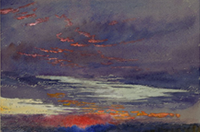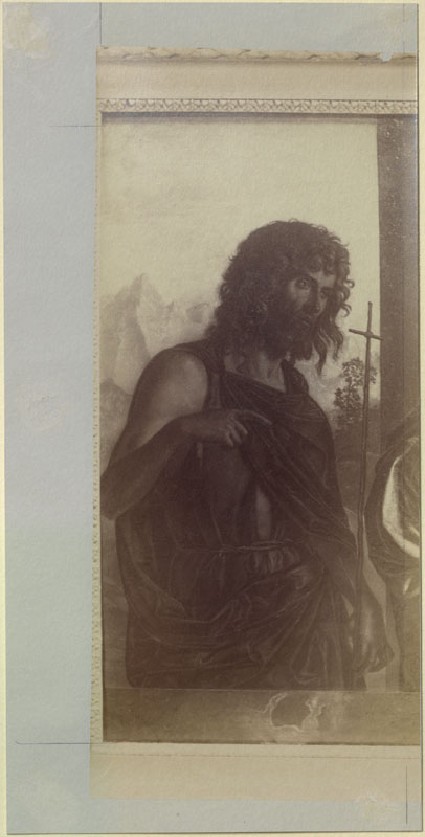Ruskin's Educational series, 2nd ed. (1874)
Ruskin's revised catalogue of 300 works for the instruction of undergraduates and his notes on the use of particular examples.

Ruskin's Catalogues: 1 object
Show search help- Reference URL
Actions
Photograph of Saint John Baptist from Cima's "Virgin and Child with Saints John the Baptist and Paul" Anonymous Italian
-
Ruskin text
1.Here, therefore, is the first of your Educational series chosen for you, not that you may try to copy, but that you may look at it, when you would be put in right temper for work. It will seem to speak to you if you look long; and say again, and yet again, ’´Ιδε—ό άϊρων. You will find the work of Cima of Conegliano referred to by me, long since, in the third volume of Modern Painters, as notable for its perfect painting of all lovely detail. His own Alps are in the distance here, and he shall teach us how to paint their wild flowers, and how to think of them.
-
Details
- Artist/maker
-
Anonymous Italian (Anonymous, Italian) (photographer)after Cima da Conegliano (1459/60 - ?1518)
- Object type
- photograph
- Material and technique
- albumen print
- Dimensions
- 270 x 120 mm (print); 297 x 148 mm (mount)
- Inscription
- On the back of the mount, centre, the Ruskin School's stamp
- Provenance
-
Presented by John Ruskin to the Ruskin Drawing School (University of Oxford), 1875; transferred from the Ruskin Drawing School to the Ashmolean Museum, c.1949.
- No. of items
- 1
- Accession no.
- WA.RS.ED.001
-
Subject terms allocated by curators:
Subjects
-
References in which this object is cited include:
References
Ruskin, John, Catalogue of the Educational Series (London: Smith, Elder, 1871), cat. Educational no. 1
Ruskin, John, Catalogue of the Educational Series (London: Spottiswoode, 1874), cat. Educational no. 1
Ruskin, John, ‘Educational Series 1878’, 1878, Oxford, Oxford University Archives, cat. Educational no. 1
Ruskin, John, Catalogue of Examples Arranged for Elementary Study in the University Galleries (Oxford: Clarendon Press, 1870), cat. Educational no. 1
Ruskin, John, ‘The Ruskin Art Collection at Oxford: Catalogues, Notes and Instructions’, Edward T. Cook and Alexander Wedderburn, eds, The Works of John Ruskin: Library Edition, 39 (London: George Allen, 1903-1912), 21, cat. Educational no. 1
Location
-
- Western Art Print Room
Position in Ruskin’s Collection
Ruskin's Catalogues
-
Ruskin's Educational series, 1st ed. (1871)
1 Head of the Baptist. (Cima da Conegliano). P -
Ruskin's Educational series, 2nd ed. (1874)
1. Head of the Baptist. (Cima da Conegliano). P -
Educational, manuscript (1878)
R No. 1This represents only a portion of a picture now in the Academy of Venice. I wished to have a head of John the Baptist to begin our series, and John the Baptist is the favourite Saint of Cima. Every Italian Painter has a favourite saint, and it seems as if the Saint has made also a favourite of the Painter, and declined to be painted by any body else; so that for everything one must go to a particular Painter. Nobody but Luini can draw a St. Catherine, nobody but Angelico a St. Lawrence, and nobody but Cima a St. John.
-
Ruskin's Catalogue of Examples (1870)
1.Here, therefore, is the first of your Educational series chosen for you, not that you may try to copy, but that you may look at, when you would be put in right temper for work. It will seem to speak to you if you look long; and say again, and yet again, ¨Ιδε—ό αϊρων. It is by good Cima of Conegliano; his own Alps are in the distance, and he shall teach us how to paint their wild flowers, and how to think of them.





